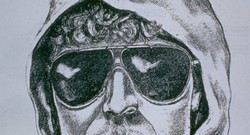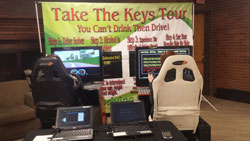James Fitzgerald, an FBI criminal profiler, discussed his role in helping to solve the Unabomber case on Wednesday, Feb. 17. The virtual event was hosted by the Guardians Club and the Criminal Justice Department.
Nicholas Sewitch, J.D., Chair of the Criminal Justice Department and Specialist Professor, introduced Fitzgerald and detailed the profiler’s accomplishments inside and outside of the FBI.
“[Fitzgerald] was doing criminal profiling before most of us knew what it was or had ever heard about it,” Sewitch said.
Fitzgerald is an expert in forensic linguistics and criminal profiling matters, as well as a media entertainment advisor, college professor, and an author of three books in his memoir series ‘A Journey to the Center of the Mind,’ Sewitch explained. “His extensive and varied law enforcement career includes high-profile cases such as the Unabomber, anthrax attacks, the JonBenet Ramsey homicide case and a DC sniper case.”
Post-FBI career, he acted as a technical adviser on the CBS TV series Criminal Minds and executive produced A&E’s Killer Profile. He was also a consulting producer for the Discovery Channel docu-series Manhunt Unabomber.
Fitzgerald joined the FBI in 1987, his first seven years in New York City before a promotion to supervisor in the Quantico profiling unit. While on vacation in the South Jersey Shore, he received a request to act as a profiler in San Francisco for 30 days on the Unabomber task force. As the case developed, 30 days turned into a year and a half.
The Unabomber sent letters to his victims before his bomb-packages arrived, creating a paper trail of his linguistic style and literary word choices. The second letter was addressed to a Professor McConnell at the University of Michigan, the Unabomber posing as a student looking for a second opinion on his dissertation. McConnell’s graduate assistant opened the package, seriously injuring him.
Years later, Fitzgerald analyzed the letter while on his flight to join the San Francisco Unabomber task force. “I had a big 3-ring binder with me and I started looking through all the evidence,” Fitzgerald said. “I didn’t know anymore about this case than anyone following it through the media.”
As the flight descended, Fitzgerald used his knowledge of the “acrostic technique” to read the left-hand side of the second letter’s column in search of a possible hidden message. Fitzgerald identified the phrase “DAD IT IS I” from the first letters going straight down. After mentioning this discovery to his new boss, he was immediately put in charge of all Unabomber case documents.
After the Unabomber’s appearance was detailed by a witness to his computer-store attack, six years passed before he offended again. “[The FBI] thought he may have been arrested in these
six years, blown himself up, or maybe got married, had kids and got a job,” Fitzgerald said. “That’s known to happen.”
Once he returned, the Unabomber began to allow the public to understand what he represents, Fitzgerald explained. The bomber always used plural pronouns such as “we” in order to give the impression of a group. On June 21, 1993, the New York Times received the first letter identifying himself.
The Unabomber was originally considered to be a lightly educated, working class person, Fitzgerald explained. The profiler began to expand the range of the bomber’s education after considering the numerous letters’ attention to proper penmanship and grammar.
“What struck me about this letter was two sentences,” Fitzgerald said. The Unabomber stated in his writing that “People with advanced degrees aren’t as smart as they think they are,” and “Apparently people without a college degree don’t count.” Fitzgerald considered these sentences a ploy to throw the FBI off from the bomber’s extensively educated background.
Eventually, the Unabomber offered a deal to the New York Times that if his manifesto were to be published in full, “we” would stop killing through bombings but reserve the right to bomb for sabotage purposes. The manifesto was eventually published in the Washington Post.
A woman at an academic conference in Paris logged on to the newly established FBI.gov website. The FBI put the manifesto on its website, where the woman identified the writing style as her brother-in-law, a man who lives in a Montana cabin.
Her husband read the term “cool-headed logicians” in the manifesto, connecting it to a letter he received from his brother with the same hyphenated phrase. The husband acquired an attorney who contacted the FBI, and the Unabomber was identified as Ted Kaczynski, a man with a Ph.D. in mathematics who had gone off the grid for many years.
Fitzgerald needed to build a case against Kaczynski in order to justify a search warrant of his cabin. With his team, Fitzgerald compared regional spellings and topics discussed between the content of Kaczynski’s letters to his family and the various writings left by the Unabomber.
The linguistic smoking gun which allowed the search warrant to be authorized was a similarity in the verbiage of “You can’t have your cake and eat it too” that appeared throughout documents. A Montana judge signed off on the first ever usage of linguistic evidence in a search warrant.
The Unabomber’s cabin was searched. Bomb-making equipment and the exact type writer considered to have written the various letters and documentation was discovered.
PHOTO TAKEN from History.com



